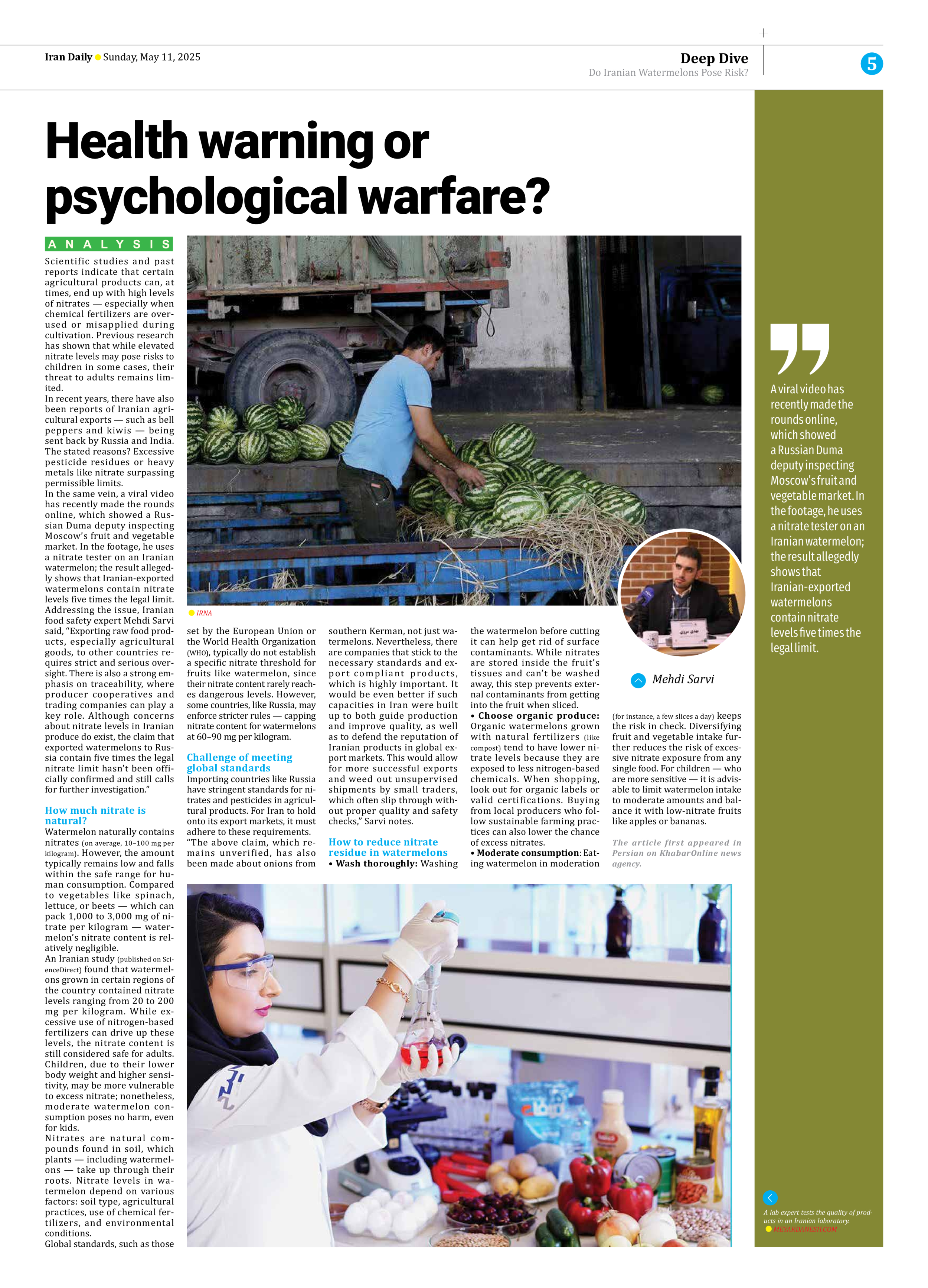
Health warning or psychological warfare?
Mehdi Sarvi
Scientific studies and past reports indicate that certain agricultural products can, at times, end up with high levels of nitrates — especially when chemical fertilizers are overused or misapplied during cultivation. Previous research has shown that while elevated nitrate levels may pose risks to children in some cases, their threat to adults remains limited.
In recent years, there have also been reports of Iranian agricultural exports — such as bell peppers and kiwis — being sent back by Russia and India. The stated reasons? Excessive pesticide residues or heavy metals like nitrate surpassing permissible limits.
In the same vein, a viral video has recently made the rounds online, which showed a Russian Duma deputy inspecting Moscow’s fruit and vegetable market. In the footage, he uses a nitrate tester on an Iranian watermelon; the result allegedly shows that Iranian-exported watermelons contain nitrate levels five times the legal limit.
Addressing the issue, Iranian food safety expert Mehdi Sarvi said, “Exporting raw food products, especially agricultural goods, to other countries requires strict and serious oversight. There is also a strong emphasis on traceability, where producer cooperatives and trading companies can play a key role. Although concerns about nitrate levels in Iranian produce do exist, the claim that exported watermelons to Russia contain five times the legal nitrate limit hasn’t been officially confirmed and still calls for further investigation.”
How much nitrate is natural?
Watermelon naturally contains nitrates (on average, 10–100 mg per kilogram). However, the amount typically remains low and falls within the safe range for human consumption. Compared to vegetables like spinach, lettuce, or beets — which can pack 1,000 to 3,000 mg of nitrate per kilogram — watermelon’s nitrate content is relatively negligible.
An Iranian study (published on ScienceDirect) found that watermelons grown in certain regions of the country contained nitrate levels ranging from 20 to 200 mg per kilogram. While excessive use of nitrogen-based fertilizers can drive up these levels, the nitrate content is still considered safe for adults. Children, due to their lower body weight and higher sensitivity, may be more vulnerable to excess nitrate; nonetheless, moderate watermelon consumption poses no harm, even for kids.
Nitrates are natural compounds found in soil, which plants — including watermelons — take up through their roots. Nitrate levels in watermelon depend on various factors: soil type, agricultural practices, use of chemical fertilizers, and environmental conditions.
Global standards, such as those set by the European Union or the World Health Organization (WHO), typically do not establish a specific nitrate threshold for fruits like watermelon, since their nitrate content rarely reaches dangerous levels. However, some countries, like Russia, may enforce stricter rules — capping nitrate content for watermelons at 60–90 mg per kilogram.
Challenge of meeting global standards
Importing countries like Russia have stringent standards for nitrates and pesticides in agricultural products. For Iran to hold onto its export markets, it must adhere to these requirements.
“The above claim, which remains unverified, has also been made about onions from southern Kerman, not just watermelons. Nevertheless, there are companies that stick to the necessary standards and export compliant products, which is highly important. It would be even better if such capacities in Iran were built up to both guide production and improve quality, as well as to defend the reputation of Iranian products in global export markets. This would allow for more successful exports and weed out unsupervised shipments by small traders, which often slip through without proper quality and safety checks,” Sarvi notes.
How to reduce nitrate residue in watermelons
• Wash thoroughly: Washing the watermelon before cutting it can help get rid of surface contaminants. While nitrates are stored inside the fruit’s tissues and can’t be washed away, this step prevents external contaminants from getting into the fruit when sliced.
• Choose organic produce: Organic watermelons grown with natural fertilizers (like compost) tend to have lower nitrate levels because they are exposed to less nitrogen-based chemicals. When shopping, look out for organic labels or valid certifications. Buying from local producers who follow sustainable farming practices can also lower the chance of excess nitrates.
• Moderate consumption: Eating watermelon in moderation (for instance, a few slices a day) keeps the risk in check. Diversifying fruit and vegetable intake further reduces the risk of excessive nitrate exposure from any single food. For children — who are more sensitive — it is advisable to limit watermelon intake to moderate amounts and balance it with low-nitrate fruits like apples or bananas.
The article first appeared in
Persian on KhabarOnline news agency.







